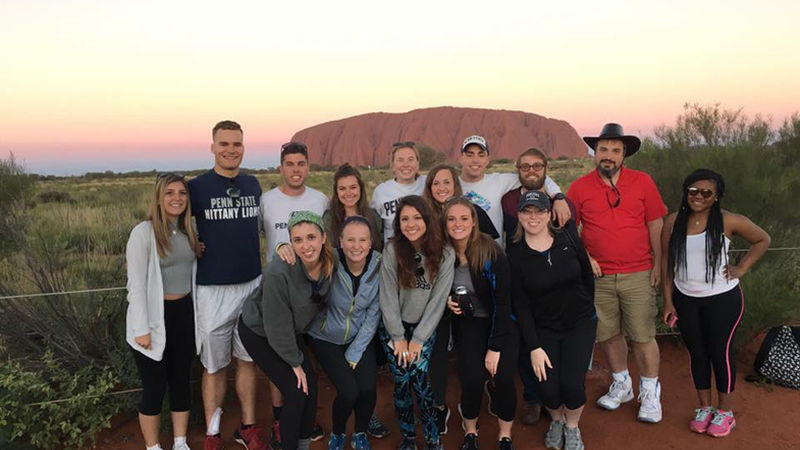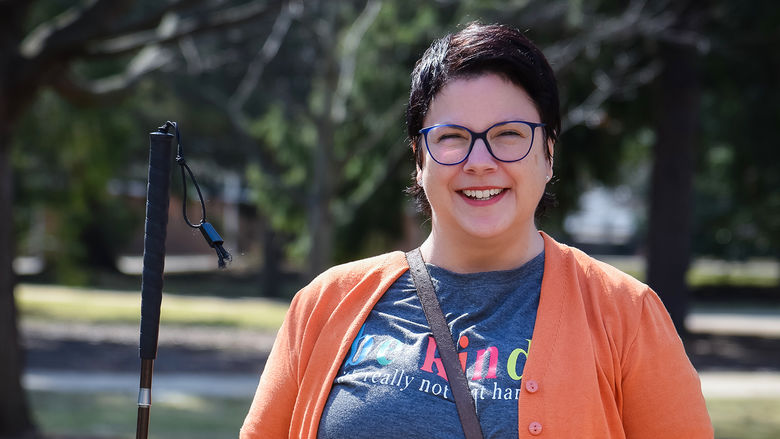

This dialog contains the full navigation menu for this site.

It’s a big world out there, and Penn State students have ample opportunity to explore it through education abroad programs. There are hundreds of options all over the globe, and this past summer, several students took advantage of a new program in Australia.
On May 13, students and faculty from across Penn State boarded a plane for the 21.5 hour flight to the Land Down Under. The first-of-its-kind study abroad program was created by Chris Smithmyer, a part-time lecturer in sociology at Penn State Altoona. Open to all Penn State students, those on the trip spent six weeks in the country and earned credits in two courses: international business, culture, and conflict in Australia; and international environmental conflict and society in Australia.
Two faculty members and three students from Altoona went on the trip, including AJ Fink, a senior history major. “I have always wanted to study abroad or go outside the country,” he said. “I was too scared to go to a country where they spoke a different language, so I thought it was a good first step to really study the world by going to an English-speaking country.” He wasn’t disappointed with his choice.
Smithmyer organized the trip in such a way that the country itself was the classroom, much of their time spent visiting relevant building and cities, and exploring in nature, becoming immersed in the culture. Their adventures kicked off in Brisbane where students observed the city’s infrastructure. There, they also visited a koala sanctuary where they were able to hold and cuddle koalas, without question a big hit with the students.
From there, travel was non-stop. Students learned how to surf on the Gold Coast, and went shark diving at Port Lincoln. “You never realize how big they are,” Fink recalled, eyes bright with the memory. “They just come out of this deep blue and appear. I loved it. I loved every second of it.” They saw kangaroos and the Sydney Opera House, a performing arts venue that is among the 20th century’s most distinctive buildings. They visited Parliament and saw a soccer game at the University of Queensland. They snorkeled in the Great Barrier Reef, went whitewater rafting in the Daintree Rainforest, and rappelled in the Blue Mountains. They spent hours hiking in national parks and rainforests and saw the incredible cave system of the Jenolan caves.
Smithmyer explained that he specifically chose as many locals as he could to serve as guides during the trip. With deep cultural roots and knowledge of their own country, they could give the students a more authentic experience. For example, the group spent several days in Australia’s Red Centre, discovering its rugged landscapes and learning about the country’s Aboriginal culture from Aborigines themselves. “It was so interesting to learn from them and about them. I was surprised to learn that there are hundreds of Aboriginal nations. Some are very westernized and abandoned their Aboriginal roots. Some embrace western culture, but keep their former culture alive, and some are very exclusive,” recalled Fink. Students also learned about the Aboriginal genocide in which hundreds of thousands indigenous Australians were massacred between 1788 and the 1920s by European invaders, its aftereffects still reverberating in the country today. “Many of the students didn’t know about that and were very persistent in asking questions trying to find out why it happened,” stated Smithmyer. “I think it really exposed them to the real world."
While in Red Centre, the group stayed near the Uluru-Kata Tjuta national park where they were able to see both the sunset and sunrise over Ayers Rock, Australia’s most recognizable natural icon, a 348 meter high sandstone monolith. The rock bears many inscriptions made by ancestral indigenous people and is sacred to a number of Aboriginal tribes in the region. “You can look at pictures in a classroom, and say, ‘oh, that's cool,’ but getting to see one of the oldest rocks in the world, getting to feel it and touch the marks that the Aborigines carved into the stone gave the students a whole different perspective,” stated Smithmyer.
The group also visited the Australian War Memorial, a surreal experience for Fink, as a member of the Army. “We were there on what is America’s Memorial Day, which, to me, was fitting. We got to see how others honor their fallen soldiers, and it was interesting. Even though we weren’t looking at the names of American lives lost, it was still a somber thing and still just as powerful.” Smithmyer said the Memorial was a highlight of the trip for him and where he saw the most change in the students. “Australia’s War Memorial is all together, and it's like being in a building with twenty-five Vietnam walls, where every soldier from the country who has ever died in combat is listed on the walls as you walk through. I think students really started to dig into things by seeing that. They started to ask what it all means, why it's all relevant.”
For Fink, the program has impacted him enormously. He said making the decision to study abroad was the first time he just threw caution to the wind and dove into the unknown. “Going to college is one thing, but going to a complete different country is another thing. It's taking a risk. And it means you trust yourself to make a lot of decisions. It was my turn to just go for something, and I’m really happy about it.” He went on to say that he finds himself thinking of the trip often and feeling very nostalgic for it and his fellow travelers. “I shared so much with them and I’ll never have those same experiences with other people. I miss it a lot. We got to go off the grid a lot. Your phone wouldn't work, you had no cell service. It was just us, coming together, hiking, going through caves, playing spoons at night.”
Fink kept a travel journal which allows him to go back and read over everything he saw and experienced. He said of all the things he was able to do on the trip, just talking to people and learning their stories was something he enjoyed most. “By listening to their stories, I got a better idea of who they are, what their culture is like, and what’s important to them, and that’s important to me.”
Despite the many differences between them, Fink discovered the similarities, as well, especially when it came to Penn State and to sports. One Australian man he met talked about his love for the “Pitty” (Pittsburgh) Steelers, the “Pitty” Pirates, and the “Pitty” Penguins. Another man he spoke with had a tattoo of former Steelers safety Troy Polamalu on his arm. And walking through the airport with their Penn State sweatshirts on, someone yelled out to them “WE ARE!” “It just reiterated to me how connected all of us are across the world,” said Fink.
Smithmyer is pleased with how well the study abroad trip went and believes the students gained fulfilling, life-changing experiences that will help shape them into responsible, aware, and culturally-sensitive adults.


